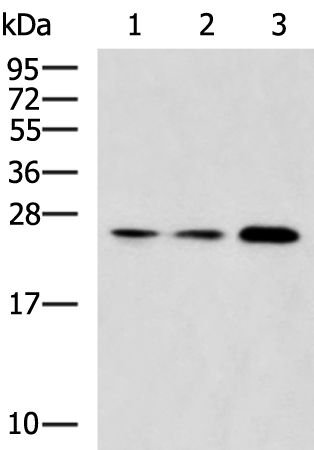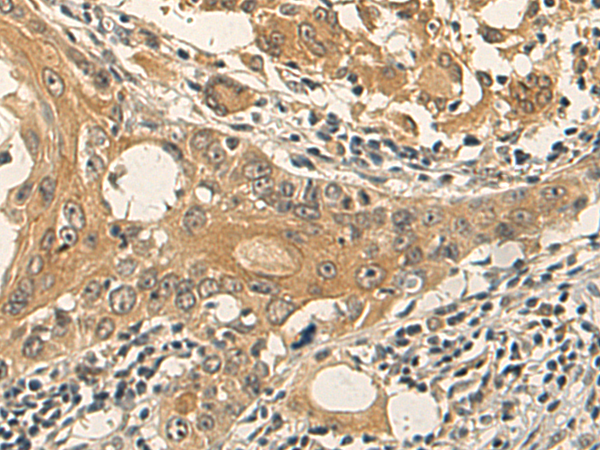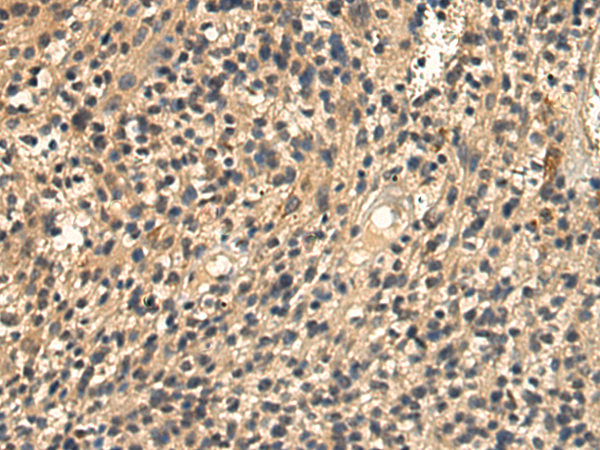


| WB | 1/500-1/2000 | Human,Mouse,Rat |
| IF | 咨询技术 | Human,Mouse,Rat |
| IHC | 1/100-1/300 | Human,Mouse,Rat |
| ICC | 技术咨询 | Human,Mouse,Rat |
| FCM | 咨询技术 | Human,Mouse,Rat |
| Elisa | 1/5000-1/10000 | Human,Mouse,Rat |
| WB Predicted band size | 25 kDa |
| Host/Isotype | Rabbit IgG |
| Antibody Type | Primary antibody |
| Storage | Store at 4°C short term. Aliquot and store at -20°C long term. Avoid freeze/thaw cycles. |
| Species Reactivity | Human, Mouse, Rat |
| Immunogen | Fusion protein of human RAB3A |
| Formulation | Purified antibody in PBS with 0.05% sodium azide and 50% glycerol. |
+ +
以下为关于RAB3A抗体的3篇参考文献,按简单格式整理:
1. **"Rab3A is essential for the formation of stable docked synaptic vesicles at presynaptic active zones"**
- 作者:Schlüter OM 等
- 摘要:研究利用RAB3A抗体进行免疫标记,发现RAB3A蛋白通过与突触前活性区的蛋白质相互作用,调控突触小泡的锚定和神经递质释放效率。
2. **"Antibody-specific detection of Rab3A in pancreatic β-cells reveals its involvement in insulin granule exocytosis"**
- 作者:Matsumoto M 等
- 摘要:通过RAB3A抗体的特异性免疫荧光染色,揭示RAB3A在胰岛β细胞胰岛素分泌颗粒的胞吐过程中起关键作用,并与糖尿病病理相关。
3. **"Rab3A antibody characterization and its role in neuronal development"**
- 作者:Geppert M 等
- 摘要:报道了RAB3A抗体的制备与特异性验证,并证明RAB3A缺失会导致小鼠神经元突触可塑性和发育异常,影响学习记忆功能。
The RAB3A antibody is a research tool used to detect and study RAB3A, a small GTPase protein belonging to the Rab family, which regulates synaptic vesicle trafficking and neurotransmitter release in neurons. RAB3A is primarily localized to presynaptic nerve terminals, where it cycles between active (GTP-bound) and inactive (GDP-bound) states to control vesicle docking, priming, and fusion with the plasma membrane. It plays a critical role in modulating synaptic plasticity and maintaining efficient synaptic transmission. Dysregulation of RAB3A has been implicated in neurological disorders, including Alzheimer’s disease and epilepsy.
RAB3A antibodies are widely employed in techniques like Western blotting, immunohistochemistry, and immunofluorescence to assess protein expression, localization, and interactions in neural tissues or cultured cells. These antibodies help identify RAB3A isoforms and their post-translational modifications, which influence its function in vesicle dynamics. Studies using RAB3A antibodies have revealed its involvement in exocytosis, synaptic maturation, and interactions with effectors like RIM1α and Munc-13. Some research also links RAB3A to non-neuronal secretory processes, such as hormone release. Validation of RAB3A antibodies is crucial, as cross-reactivity with other Rab isoforms (e.g., RAB3B/C/D) may occur. Overall, RAB3A antibodies are essential for exploring molecular mechanisms of synaptic function and disease-related pathways.
×